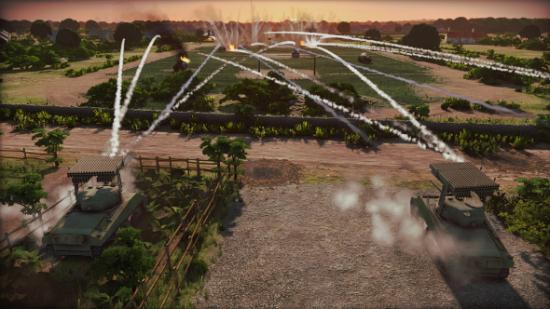The new real-time strategy game from Eugen Systems, Steel Division: Normandy 44, takes the genre back to the grit and brutality of the Second World War. However, while the genre and setting might call to mind the nostalgia of classic WW2 RTS titles like Sudden Strike, Blitzkrieg and Soldiers: Heroes of World War II, its gameplay mechanics are shaping up to be just as complex and deep as those of a grand strategy franchise like Hearts of Iron. Further to that end, Eugen Systems are partnering up with Paradox Interactive, making this something of a strategy gaming dream team.
Recognise the ping of a spent M8 Garand clip anywhere? Check out the best WW2 games on PC.
Historical accuracy is at the fore of Steel Division: Normandy 44, so much so that the game maps themselves have been put together using recon photos from the conflict – every road, hedgerow and building exists as it would have done ahead of the Battle of Normandy. Eugen Systems are toiling away creating over 400 units for the game, with variations for every nation involved in the conflict, all in the name of realism. Their mechanics are designed to simulate the realistic ebb and flow of a real battle as well: there are suppression and stress mechanics, a total absence of health bars, elite units based on famous units from the battle and phases that simulate what types of units enter the fray at what stage of the battle.
We spoke to the developers at GDC 2017 about Steel Division: Normandy 44’s systems so that we could break it down for you here.
Steel Division: Normandy 44 divisions
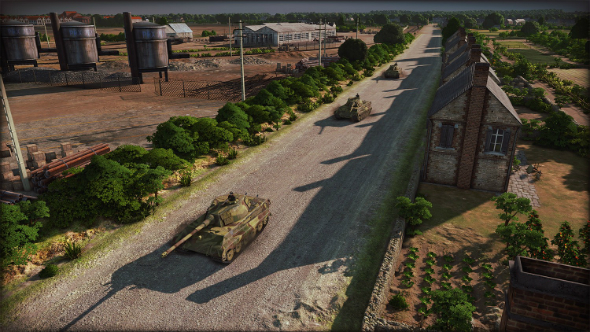
There’s a hint in the game title, but suffice it to say that what sets Steel Division: Normandy 44 apart from grand strategy and RTS games set during the Second World War is that the focus is on divisions rather than whole armies. Instead of choosing between the Allied or Axis armies, you choose a specific division that would have been at the Battle of Normandy.
“In a tactical game you embody a colonel,” explains creative director Alexis Le Dressay. “The main point is: from which division do you belong? Belonging to a division is really important because all the divisions are different. They have different units, elite units – they have different military warfare.”
With a total of 18 different divisions in the game, such as the US 101st Airborne Division and the 12th SS Armoured Division, there’s a lot of variation in the minute by minute gameplay, as well as your options before starting a battle. If you pick the aforementioned US 101st Airborne Division for example, you’ll only have access to two types of tank, but your infantry units are among the best in the game in terms of strength and depth. This makes you especially adept in the first phase of a battle, where your speed allows you to push and set up ambushes along the frontline. You might struggle more in later phases where heavier hardware comes into play, but if you do your job at the start of the battle you’ll have enough of an advantage to hold out for a victory.
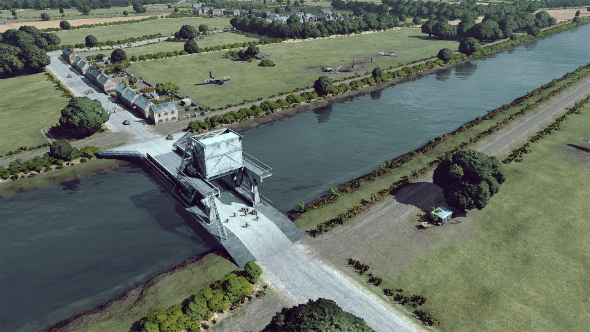
Alternatively, you can take control of the German 21st Panzer Division, one of Rommel’s divisions that spent the first two years of the war in Africa, and the only Panzer division to engage Allied forces on the first day of the battle. Like every division in Steel Division: Normandy 44, the 21st Panzer Division has an ace in the hole: a captured US Sherman Firefly tank. “As it is an armoured division,” says Le Dressay, “we’ve got a lot of slots in armoured and tank units. We’ve got a maximum of 36.” However, in the first phase of the battle however, we only have two slots for armoured units – this is the same phase where infantry-led divisions like the 101st excel – and Germany lack decent light tanks to use at this stage of the fight. Enter the captured US Sherman Firefly, which should provide the 21st with a helping hand during Phase A without wasting two valuable Armoured slots that could be essential later on.
In this regard, Steel Division: Normandy 44 shares some characteristics with MOBAs, inasmuch as divisions have strengths, weaknesses and specials, which make them more or less effective at different stages of the game.
Steel Division: Normandy 44 multiplayer
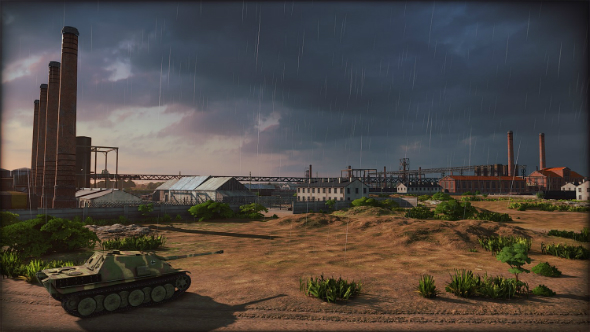
That MOBA comparison gains more traction when you consider how divisions work in multiplayer, where players can pick divisions that complement one another during different battle phases.
“Not only does it depend on who you’re fighting,” explains Peter Cornelius, producer at Paradox Interactive, “but also your playstyle. When I played the Airborne I used a lot of artillery and a lot of recon – it’s so different. And then of course when you play four versus four, or more, ten versus ten, you have to really communicate with your co-players. Like, ‘Okay, if you’re going to be armoured, I’ll get you a foothold in Phase A, I’ll cover you with artillery. You have to really think about your combinations.”
Another interesting facet about how multiplayer changes the game is how the map size varies. As you’d expect, the maps get much larger when you have more divisions on the playing field. However, they generally just get wider, rather than deeper. The reason for this is that Eugen Systems don’t want players having to take their divisions on a road trip – the interesting action is around the frontline.
Steel Division: Normandy 44 units
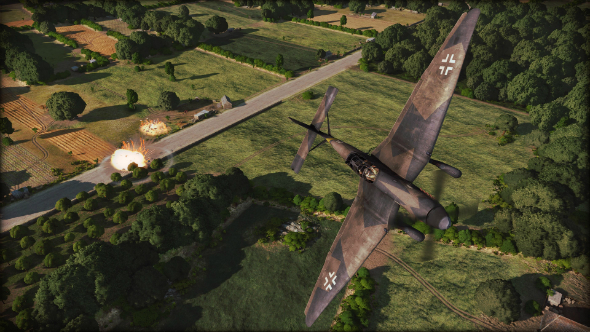
The concept of units and elite units won’t be abstract to anyone who’s played a strategy game before, but Steel Division: Normandy 44 is hoping to imbue its over 400 units with all the historical accuracy and compositional variations of their real-world counterparts fighting at the Battle of Normandy. As such, Eugen Systems aren’t just drawing influence from the most obvious places like the German, US and British armies.
For example, if you choose a Polish division, all of the units in that division are actually Polish, rather than re-skinned US units. The same goes for the game’s Scottish division, which is a unique band complete with its own elite units and strengths that will differ from those of a typical British Army infantry division. Taking into consideration these national differences in a unit’s exact composition, Peter Cornelius estimates there to be well over 600 units in the game.
Steel Division: Normandy 44 phases
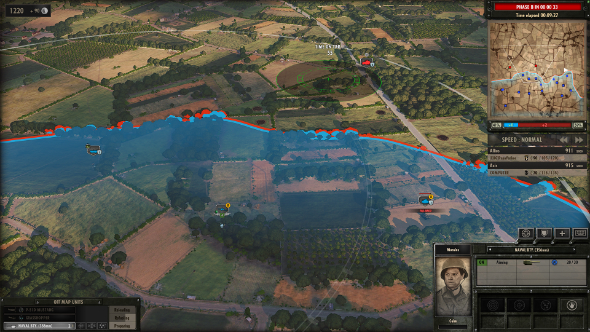
A battle in Steel Division: Normandy 44 takes place over four distinct stages: Phase A, B and C as well as a deployment phase. As this is a real-time strategy game, phases tick over as time goes by, with each phase running for ten minutes. The deployment phase is the only part of a battle that takes place out of real time. In this phase you can deploy units in zones, effectively letting you weight your attack around certain flanks. Next comes Phase A: in this phase you’re limited in terms of how many armoured vehicles you can deploy, which makes this a great time to advance with infantry and recon units that can establish your presence on the frontline. Phase B is when you’ll start rolling in light and medium tanks and stronger units. Phase C is reserved for your heavy armour.
The reason for this is to replicate the real ebb and flow of warfare in the Second World War. Throughout each phase you’ll earn points to spend on more units; in Phase A you won’t earn many points per minute, which limits your options when it comes to moving in armoured vehicles. By Phase C however, you’ll be earning huge numbers of points, meaning you’ll be able to deploy your best and most devastating units.
Once again, this is all in the name of realism. “When we start we have 500 points that you can set,” explains Le Dressay. “Then after I will be granted 90 points each minute. In fact it’s 90 points depending on each division – the division I’m facing only has 70. But then, you will go to Phase B. Phase A is the recon combat unit battle. Only the light units will be available. The light vehicles, the light tanks. I’m not able to call in reinforcements. Then you go to Phase B – it’s getting bigger. This is depicting the logistics [needed] to deploy all of this fighting force. Phase B is usually very big tanks, very heavy tanks.”
Steel Division: Normandy 44 suppression and stress
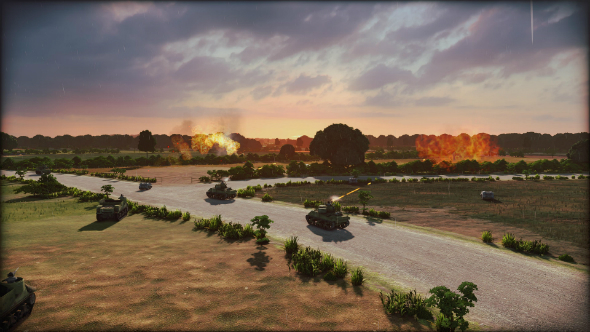
Eugen Systems have one particular gripe with how RTS games deal with units being destroyed: health bars. Two infantry units fighting it out, chipping away at each other’s health points until whoever opened fire first emerges victorious, albeit battered. That’s not how war happens in the real world, says Le Dressay. ”One thing we have in the game is this two-paced gameplay. First thing, you try to prevent the enemy from shooting on you, by shooting on them a lot. Second thing, destroying it. What we wanted to prevent was to have was health bars and stuff like that – absolutely not realistic.”
Of course that doesn’t mean units won’t sustain losses, but it does mean that those losses are sustained in a much more realistic manner, and you don’t necessarily have to chip away at an enemy until they’re all dead as you can force them to surrender.
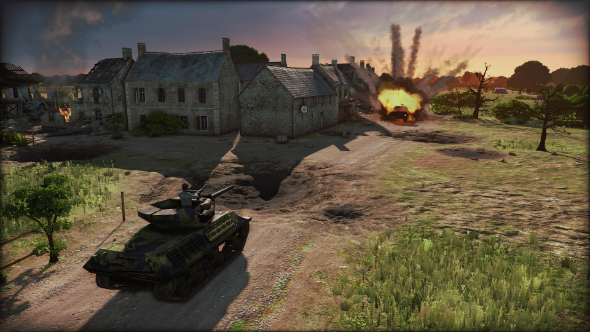
The system even applies to tanks, which can be forced to retreat by units that can’t even do any damage to them. The system differs slightly to the suppression mechanic that applied to infantry, this is all about stressing armoured units out in order to temporarily force them out of action. “Say you are in a heavy tank,” says Cornelius, “and the enemy are shooting at you with some 20mm machine guns, they are not going to do jack to that tank. You’re fine. But inside, all they hear is ‘DING DING DING DING DING DING’. So they are going to get stressed. When a vehicle gets too stressed, it’s just like, ‘Crap, I’m out of here’, and they will just rout.”
Naturally, there’s a counter to this in the form of commanding units, which provides a morale boost to all nearby troops that make them much harder to become stressed or pinned down. Likewise, more experienced units will not only be much harder to stress out, they will also get into position and take aim more quickly. It’s easy to see how a complex a single division can be.
Steel Division: Normandy 44 campaigns
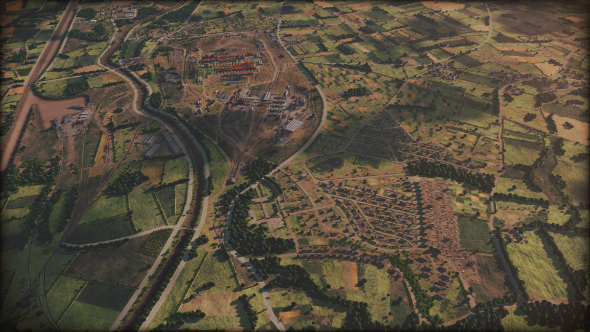
According to Le Dressay, Steel Division: Normandy 44 will have three campaigns. “We have an American campaign, a German campaign and a British campaign. They are all depicting realistic operations. And campaigns have several missions that are all bound together. The units you have on the first mission, you have to take care not wasting them, because they are persistent.”
That persistent element will no doubt make completing a campaign very, very difficult as you’ll have to manage your troops based on what dangers you might encounter later on in the campaign. There will be reinforcements, but certain reinforcements will be locked off at various points in each campaign to reflect the historical situation that was unfolding at the time.
That’s everything we know about Steel Division: Normandy 44. If you’re excited for what Paradox and Eugen Systems are cooking up, let us know why in the comments below.
